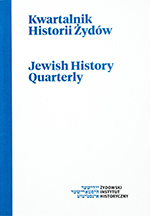Socioeconomic and Demographic Patterns of the 17th-18th-Century Jewish Population in the Grand Duchy of Lithuania
Socioeconomic and Demographic Patterns of the 17th-18th-Century Jewish Population in the Grand Duchy of Lithuania
Author(s): Arvydas MaciulevičiusSubject(s): History
Published by: Żydowski Instytut Historyczny
Keywords: Jews; Estate inventories; Birże; Kiejdany; Radziwiłł family; Jewish settlement; Jewish family
Summary/Abstract: Based on estate inventories, the present article seeks to analyse the nature of the information these sources provide for researchers interested in Jewish history. In view of the current situation in research, the 17–18th century inventories of two private cities, Birże (Birzai) and Kiejdany (Kedainiai), were selected: until now, they have been explored scantily or have not been used for research into Jewish communities at all. Considering the fact that studies exploring the history of the Jews in the Grand Duchy of Lithuania (hereinafter referred to as the “GDL”) pay rather scant attention to the cities of Birże and Kiejdany. Until this day, it has been little known about the settlement of the Jews in these cities, located in the territory of present-day Lithuania, which in the 17th century served as part of the most important residences of the Birże-Dubinki branch of the Radziwiłł family. Based on the 17–18th century inventories of Birże and Kiejdany, the article reconstructs the Jewish living space in the city. Comparing the data of inventories with juxtaposed sources defining the restrictions on the Jewish living space, the article shows that in reality the prohibitions at issue were not being followed and the settlement of the Jews in the city extended beyond landed property within the Jewish quarter. While analysing the demographic and socioeconomic structure of Jewish communities, inventories prove to provide some significant information, however, due to the nature of the compilation of these sources, they come short of the information contained in modern censuses. It is however worthwhile to note that private Radziwiłł estates used to compile the so-called “Jewish Censuses” which, in their nature, are similar to those comprehensive censuses of the Jews in Poland and the GDL, dating to the 1760s, as they list not only Jewish citizens – house-owners – but the persons living with them as well. This enables researchers to learn about the size of the then Jewish family without any speculation as to how many people had actually lived in one household in the 17–18th century. Estate inventories are of significance not only when analysing the demographic situation of the Jewish population in a city. They reflect the socioeconomic status of the Jewish community as well. Based on these sources, it is possible to partially reconstruct the socioeconomic structure of the Jewish community. Although 17th century inventories rarely distinguish the occupation the persons listed had been engaged in, more relevant information is found in analogous sources of the 18th century. On the other hand, the analysis conducted in the field of estate inventories and presented in the article has revealed that it is purposeful to compare this kind of sources to the information of juxtaposed sources for the sake of more comprehensive explanations, clarity and better knowledge.
Journal: Kwartalnik Historii Żydów
- Issue Year: 254/2015
- Issue No: 02
- Page Range: 203-230
- Page Count: 28
- Content File-PDF

